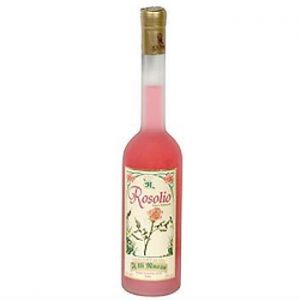
Introduction to Rosolio
Alcoholic beverages are prepared all over world; they have been made and consumed since ancient times. In many religions, wine and other alcoholic beverages are used in their ceremonials and offered to their members in the ritual functions. Alcoholic beverages were born, when people become aware that macerated or fermented fruits, grains or herbs produced a beverage with unique characteristics which affected the body and the mind. It was believed that this drink was an aphrodisiac, and realized that would mitigate suffering and pains; that it would give a sense of euphoria and relaxation, and as a final point, it was assumed that it was a gift from the gods so administered by the priests in religious services.
In some parts of the world, this fermented infusion of fruits, nuts or herbs was sweetened with honey and made into a drink to enjoy for its taste and to use for leisure or as an herbal mixture to help with illnesses. In the XII century, alchemists and scholars of the Medical School of Salerno identified the Sundew flower, Drosera Rotundifolia in Italian and Ros Solis in Latin, beneficial in the cure of whooping cough and also effective as an aphrodisiac. The medical components of the sundew, the carotenoids which enhance and help the function of the immune and reproductive systems, the flavonoids which is a beneficial antioxidant and contains many vitamins, are in fact valid cures for coughs, lung infections, asthma and other conditions. When the infusion of Ros Solis was prepared in Salerno, because of the therapeutic attribute it was believed to possess and because of the pleasant taste, it became the drink much sought-after, preferred in all European courts, in all the noble’s sitting rooms and the most favorite afternoon drink.
Also to address other health problems, some ingredients were substituted and the original formula evolved into many varieties called rosolio jointly with the name of the infusion’s basic component. For instance when the sundew flowers were replaced by bay leaves as a remedy for stomach troubles it became laurel rosolio, the basil rosolio was a tonic to alleviate spasms, the absinthe rosolio made with a liquorish tasting herb called assenzio, was a selected preparation to stimulate the appetite, to combat high fever and as a diuretic. The name Rosolio became a symbol of a fine drink and the name Rosolio or Rosolii as the plural, was added to the drinks on hand.
HOME MADE ROSOLIO
As many new versions and flavors of rosolio came out, in Europe, and in all Mediterranean countries, the rosolio was produced in the family’s kitchens and commercially in abbeys and monasteries. Although the sundew flowers are no longer used to make rosolio, still some people believed that the word rosolio meant rosa-olio, oil of roses, still make an infusion of rose petals and blend it with sugar and alcohol. Liquors are available in many flavors, fruits or nuts based and available in liquor stores.
Homemade rosolio is easy to make, does not require any equipment save for a little patience and time. There are no strict rules or recipes to make rosolio, because you have to be the judge in making a sweeter or stronger rosolio: by increasing the amount of alcohol and/or sugar will give a stronger or sweeter rosolio and a lighter rosolio by decreasing above amounts.
ROSOLIO RECIPES
